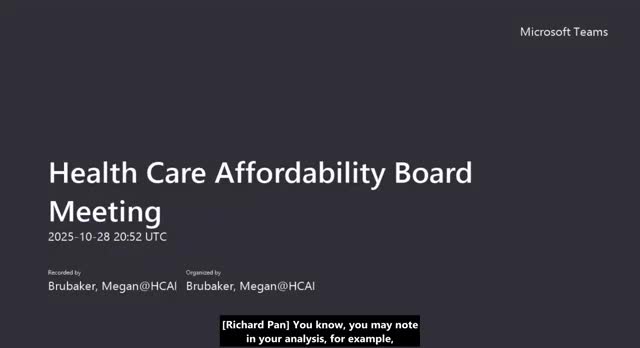HCAI board questions $5 maximum penalty and asks staff to draft clearer enforcement motion for November
November 08, 2025 | Department of Health Care Access and Information, Agencies under Office of the Governor, Executive, California
This article was created by AI summarizing key points discussed. AI makes mistakes, so for full details and context, please refer to the video of the full meeting. Please report any errors so we can fix them. Report an error »

At a Department of Health Care Access and Information board meeting, members questioned whether a proposed maximum penalty — cited in staff materials as $5 and shown in analysis as producing an average impact of about 1.46% of a health plan’s annual net profit — is large enough to deter noncompliance.
Board members said the staff analysis shows a range from negative 3% to 3.8484% and raised concerns that firms might treat a small maximum penalty as a cost of doing business. "If someone says, oh, okay. Well, it's gonna cost me 1.46% of my profit or 2% or something. So I I not sure how much of a deterrence that is if you decide it's a cost of business," said Board member 1.
Another member asked staff to recheck the underlying statistics used in the analysis, noting typical plan revenue assumptions and questioning whether the $5 penalty was being compared to the correct base. "If profit is 5% of revenue, that'd be $45 a month. So it doesn't sound right to me that $5 a month is 1.46%. It seems like it should be closer to 10% ... I'd request a review of those statistics," said Board member 4.
Members also sought clarity on enforcement pathways. One board member asked whether the office could design a revenue‑based penalty or must limit remedies to the state health plan, and requested examples of how the Department of Managed Health Care (DMHC) or administrative‑law processes have been used in similar cases. "I would like to understand a little bit more about what say DMHC's experience has been with administrative actions ... just to understand what it means to practically enforce this law through a law judge," said Board member 5.
A speaker identifying CalPERS practice said CalPERS uses independent grievance processes that can escalate to administrative‑law judges but typically enforces terms through contract provisions. "For the most part, these are ... the kinds of things that we put in contract and, and enforce through contract," said the CalPERS representative.
Board members emphasized that the $5 cited in staff materials represents a maximum penalty and that staff retain discretion to adjust enforcement responses. "This would be the maximum penalty. So ... staff does have some discretion ... We're talking about the upper end, and I think the upper end may be a little too low," Board member 1 said.
Without additional discussion, a board member moved that staff use the information from the meeting to draft an additional motion for consideration at the November meeting clarifying how various remedies interact. The mover then advanced the agenda to item 5(b).
Board members said the staff analysis shows a range from negative 3% to 3.8484% and raised concerns that firms might treat a small maximum penalty as a cost of doing business. "If someone says, oh, okay. Well, it's gonna cost me 1.46% of my profit or 2% or something. So I I not sure how much of a deterrence that is if you decide it's a cost of business," said Board member 1.
Another member asked staff to recheck the underlying statistics used in the analysis, noting typical plan revenue assumptions and questioning whether the $5 penalty was being compared to the correct base. "If profit is 5% of revenue, that'd be $45 a month. So it doesn't sound right to me that $5 a month is 1.46%. It seems like it should be closer to 10% ... I'd request a review of those statistics," said Board member 4.
Members also sought clarity on enforcement pathways. One board member asked whether the office could design a revenue‑based penalty or must limit remedies to the state health plan, and requested examples of how the Department of Managed Health Care (DMHC) or administrative‑law processes have been used in similar cases. "I would like to understand a little bit more about what say DMHC's experience has been with administrative actions ... just to understand what it means to practically enforce this law through a law judge," said Board member 5.
A speaker identifying CalPERS practice said CalPERS uses independent grievance processes that can escalate to administrative‑law judges but typically enforces terms through contract provisions. "For the most part, these are ... the kinds of things that we put in contract and, and enforce through contract," said the CalPERS representative.
Board members emphasized that the $5 cited in staff materials represents a maximum penalty and that staff retain discretion to adjust enforcement responses. "This would be the maximum penalty. So ... staff does have some discretion ... We're talking about the upper end, and I think the upper end may be a little too low," Board member 1 said.
Without additional discussion, a board member moved that staff use the information from the meeting to draft an additional motion for consideration at the November meeting clarifying how various remedies interact. The mover then advanced the agenda to item 5(b).
Don't Miss a Word: See the Full Meeting!
Go beyond summaries. Unlock every video, transcript, and key insight with a Founder Membership.
✓
Get instant access to full meeting videos
✓
Search and clip any phrase from complete transcripts
✓
Receive AI-powered summaries & custom alerts
✓
Enjoy lifetime, unrestricted access to government data
30-day money-back guarantee

